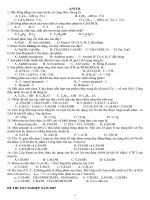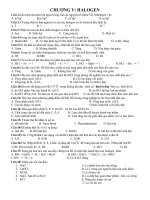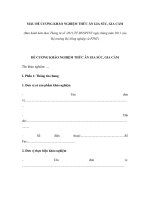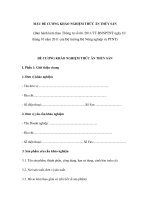Đề cương trắc nghiệm Hành Vi Tổ Chức (Organizational Behavior) CHƯƠNG 7
Bạn đang xem bản rút gọn của tài liệu. Xem và tải ngay bản đầy đủ của tài liệu tại đây (47.71 KB, 15 trang )
Chapter 7: Workplace Emotions, Values,
and Ethics
7-1. Love, sadness, and surprise represent:
a. Perceptions
b. Emotions
c. Attitudes
d. Behavioural intentions
e. Values
The question was not answered. The correct answer
is "b". (Coaching responses are only available for answered
questions)
7-2. Emotions are _____ , whereas attitudes are _____.
a. experienced feelings, judgments
b. perceptions, values
c. fictitious, real
d. thoughts, behavioural tendencies
e. real, fictitious
The question was not answered. The correct answer
is "a". (Coaching responses are only available for answered
questions)
7-3. Which of these is not a category of emotions identified in the
text?
a. Fear
b. Sadness
c. Surprise
d. Love
e. Values
The question was not answered. The correct answer
is "e". (Coaching responses are only available for answered
questions)
7-4. Which of these represent the cluster of beliefs, assessed
feelings, and behavioural intentions toward an object?
a. Attitude
b. Values
c. Personality
d. Moods
e. Perception
The question was not answered. The correct answer
is "a". (Coaching responses are only available for answered
questions)
7-5. Which component of attitude represents a positive or negative
assessment of our emotional experiences related to the attitude
object?
a. Behavioural intentions
b. Values
c. Feelings
d. Perceptions
e. Beliefs
The question was not answered. The correct answer
is "c". (Coaching responses are only available for answered
questions)
7-6. What do people experience when their beliefs, attitudes,
intentions, and behaviours are inconsistent with one another?
a. Uncertainty avoidance
b. Cognitive dissonance
c. Negative affectivity
d. Organizational commitment
e. Emotional intelligence
The question was not answered. The correct answer
is "b". (Coaching responses are only available for answered
questions)
7-7. Researchers have found that:
a. Most people have excessive levels of negative affectivity.
b. Emotions are unaffected by personality traits.
c. Positive affectivity is a form of cognitive dissonance.
d. Positive and negative affectivity influence our emotions to
some extent.
e. Positive affectivity has a much stronger effect on our emotions
than the immediate situation.
The question was not answered. The correct answer
is "d". (Coaching responses are only available for answered
questions)
7-8. Which of these concepts is part of the job satisfaction model?
a. Expectancy theory
b. Team cohesiveness
c. Self-leadership
d. Goal setting
e. Equity theory
The question was not answered. The correct answer
is "e". (Coaching responses are only available for answered
questions)
7-9. Surveys indicate that between ______ percent of Canadians are
moderately or very satisfied overall with their jobs.
a. 82 and 86
b. 23 and 29
c. 10 and 15
d. 93 and 98
e. 31 and 47
The question was not answered. The correct answer
is "a". (Coaching responses are only available for answered
questions)
7-10. Job performance leads to job satisfaction under which of these
conditions?
a. When performance is twice than what was expected
b. When performance is linked to punishment
c. When performance is at par
d. When performance is linked to valued rewards
e. When command and control management style is implemented
The question was not answered. The correct answer
is "d". (Coaching responses are only available for answered
questions)
7-11. Which of the following actions is most likely to increase
continuance commitment?
a. Keep employees informed of organizational events
b. Offer employees large stock options that pay out only after a
long period of service
c. Involve employees in organizational decisions
d. Ensure that the employee's psychological contract is not violated
e. Demonstrate the management trusts its employees
The question was not answered. The correct answer
is "b". (Coaching responses are only available for answered
questions)
7-12. Which of the following tends to increase when employees are
involved in organizational decisions?
a. Affective commitment
b. Cognitive dissonance
c. Continuance commitment
d. Unethical conduct
e. Emotional dissonance
The question was not answered. The correct answer
is "a". (Coaching responses are only available for answered
questions)
7-13. When interacting with co-workers, customers, suppliers, and
others, employees are expected to act according to:
a. Display rules.
b. Our current level of job satisfaction
c. Our true emotions.
d. Our moral intensity.
e. Our level of emotional dissonance.
The question was not answered. The correct answer
is "a". (Coaching responses are only available for answered
questions)
7-14. Conflict between required and true emotions is called
a. display rules.
b. cognitive dissonance.
c. negative affectivity.
d. moral intensity.
e. emotional dissonance.
The question was not answered. The correct answer
is "e". (Coaching responses are only available for answered
questions)
7-15. Emotional intelligence includes all of these dimensions
EXCEPT:
a. self-awareness.
b. self-regulation.
c. self-motivation.
d. self-satisfaction.
e. social skills.
The question was not answered. The correct answer
is "d". (Coaching responses are only available for answered
questions)
7-16. Researchers have traditionally distinguished values as:
a. Past or future oriented.
b. Attitudinal or behavioural.
c. Geographical or demographic.
d. Cognitive or emotional.
e. Instrumental or terminal.
The question was not answered. The correct answer
is "e". (Coaching responses are only available for answered
questions)
7-17. In terms of cultural values, Canada has relatively high:
a. individualism
b. Power distance
c. long-term orientation
d. Nurturing orientation
e. Collectivism.
The question was not answered. The correct answer
is "a". (Coaching responses are only available for answered
questions)
7-18. The degree of which an issue demands the application of
ethical principles refers to
a. utilitarianism.
b. distributive justice.
c. moral intensity.
d. action learning.
e. ethical sensitivity.
The question was not answered. The correct answer
is "c". (Coaching responses are only available for answered
questions)
TRUE or FALSE
7-1. Emotions are experiences, whereas attitudes are judgements.
True / False
The question was not answered. The correct answer
is "True". (Coaching responses are only available for answered
questions)
7-2. Some of the major categories of emotions include collectivism,
power distance, and organizational citizenship.
True / False
The question was not answered. The correct answer
is "False". (Coaching responses are only available for answered
questions)
7-3. Feelings result from our emotions about the attitude object.
True / False
The question was not answered. The correct answer
is "True". (Coaching responses are only available for answered
questions)
7-4. Discrepancy and equity theories predict that as reality meets
and exceeds expectations, job satisfaction will decrease.
True / False
The question was not answered. The correct answer
is "False". (Coaching responses are only available for answered
questions)
7-5. The level of job satisfaction reported in one culture is directly
comparable to the level of satisfaction reported in another culture.
True / False
The question was not answered. The correct answer
is "False". (Coaching responses are only available for answered
questions)
7-6. Continuance commitment occurs when employees believe it is
their own personal interest to remain with the organization.
True / False
The question was not answered. The correct answer
is "True". (Coaching responses are only available for answered
questions)
7-7. Employees with low affective commitment tend to have higher
work motivation and organizational citizenship.
True / False
The question was not answered. The correct answer
is "False". (Coaching responses are only available for answered
questions)
7-8. Self-serving bias is one of the dimensions of emotional
intelligence.
True / False
The question was not answered. The correct answer
is "False". (Coaching responses are only available for answered
questions)
7-9. Emotional labour refers to any work activity where the
employee experiences job dissatisfaction.
True / False
The question was not answered. The correct answer
is "False". (Coaching responses are only available for answered
questions)
7-10. Emotional dissonance occurs when our true emotions conflict
with the emotions we are required to display.
True / False
The question was not answered. The correct answer
is "True". (Coaching responses are only available for answered
questions)
7-11. Instrumental values are desirable modes of behaviour that
helps us reach the objectives of terminal values.
True / False
The question was not answered. The correct answer
is "True". (Coaching responses are only available for answered
questions)
7-12. Employees with low uncertainty avoidance value structured
situations where rules of conduct and decision making are clearly
documented.
True / False
The question was not answered. The correct answer
is "False". (Coaching responses are only available for answered
questions)
7-13. People who are able to recognize the presence and importance
of an ethical issue have a high level of ethical sensitivity.
True / False
The question was not answered. The correct answer
is "True". (Coaching responses are only available for answered
questions)









